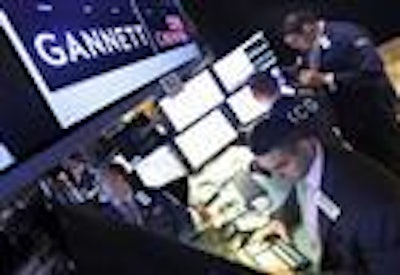

NEW YORK (AP) — The newspaper business is shrinking fast. Print ad revenues keep falling, and cost-cutting is the mantra of the day. So why is Tribune Publishing fighting so hard to avoid the embrace of USA Today owner Gannett?
It may come down to a clash of bean-counters against visionaries — assuming, of course, it's not just about holding out for the best price.
Gannett wants Tribune — the company behind the Los Angeles Times, the Chicago Tribune and other major daily papers — because bigger is better in a shrinking industry. Gannett can cut costs through employee layoffs and other measures and sell more ads with more heft. And it could add to the company's prestige in the insular world of media.
"The more papers they add, the more they can do, both in terms of cost-cutting and news projects with all their papers," Poynter Institute media analyst Rick Edmonds says. "They're doing investigative projects that involve all their papers."
Tribune is hurting along with the rest of the industry; its publishing revenue is down 60 percent since 2005, to $1.7 billion, while paid circulation for Sunday editions of its 11 major metropolitan dailies fell 43 percent to 2.4 million copies last year (though that's not a strict comparison, as Tribune has shuffled its newspaper portfolio over that period.) But it says it's not interested in becoming another cog in the Gannett consolidation machine.
Instead, Tribune is set on transforming itself into a tech-focused, global media company. Its plan — centered on harnessing artificial intelligence and rebuilding the Los Angeles Times into a leading international publication — sounds great. Never mind for the moment that many analysts consider that strategy both vague and, from what they can make of it, it a long shot at best.
The clash may come to a head this week. So far, Tribune has resisted as much as it can, calling Gannett's sweetened offer of $864 million too low . Gannett, meanwhile, is focused on Tribune Publishing's annual meeting on Thursday. It's urging Tribune shareholders to reject management's eight board candidates to send a message in support of Gannett's takeover bid.
That vote remains up in the air. The vulture fund Oaktree Capital Management, now Tribune's No. 3 investor, wants the company to accept Gannett's offer. So does another large shareholder, Towle & Co., which says Tribune is pursuing an "unreasonable, capital destructive position."
But two often influential shareholder advisory companies recommend that Tribune investors stiff-arm Gannett with a yes vote. They argue that its bid greatly undervalues Tribune and its prospects under new leadership and the company's emerging strategic plan. Gannett says it will determine whether to continue with its bid after the meeting.
Should Gannett walk away, it's up to Tribune chairman Michael Ferro, who took the helm in February, to turn his grand vision into reality. Ferro recently convinced health-care billionaire Patrick Soon-Shiong to invest $70.5 million in Tribune, making him the company's second-largest shareholder and a bulwark against Gannett.
While Tribune still plans its own cutbacks, it is pouring its energy into a major revamp of the LA Times intended to make it global source of entertainment news. Among other things, the Tribune plans calls for the paper to open seven new international bureaus this year and the creation of undefined "strategic partnerships."
Making all that happen would be a feat. To compete, the LA Times would need to develop a globally recognized brand with must-read stories that helps it amass paying customers, especially digital customers. Only a handful of other big papers have made a similar leap since the internet hollowed out the economics of print, and publications like the New York Times and the Wall Street Journal already had an international focus.
"The LA Times could have been a franchise like the New York Times, but it's been robbed of resources for a decade," says Huber Research analyst Douglas Arthur.
Tribune also says it will use automation and artificial intelligence to customize stories and ads for online readers — a move that would theoretically make it more valuable to advertisers. Soon-Shiong, who is worth nearly $12 billion according to Forbes, has agreed to let Tribune use more than 100 of his investment firm's "machine vision and artificial intelligence technology patents" for news applications. Of course, it's almost impossible to know how valuable that technology is.
What's more, Tribune is headed for a fight — not just with its old rivals, but entirely new, purely digital outfits like BuzzFeed and Vox. Merely catching up in an era when many readers get their news on mobile devices via Facebook and other social media presents a huge challenge for Tribune.
"I don't find it very persuasive," Edmonds says of the company's plan. He says it would take "a long time" to transform the LA Times into a global brand and to create a personalized, AI-powered news service — time that Tribune probably doesn't have.
Similarly, the company's digital ad plan might be too little, too late. The Tribune lags well behind mainstream pioneers like the New York Times, which still faces cost pressures after a decade of investment in its digital business, Arthur argues.
The Times, he says, is "still a long way from crossing over" to the point where digital revenues make up for losses in print. That doesn't bode well for Tribune's own grandiose plans.
In a statement, Tribune said that it's still in the "early stages" of a plan to "dramatically expand revenue and profitability." The company said that Gannett "has yet to put forth a compelling offer to acquire Tribune."
Gannett spokesman Nick Leasure declined to comment.
___
Follow Tali Arbel at twitter.com/tarbel and read more articles at http://bigstory.ap.org/content/tali-arbel






















